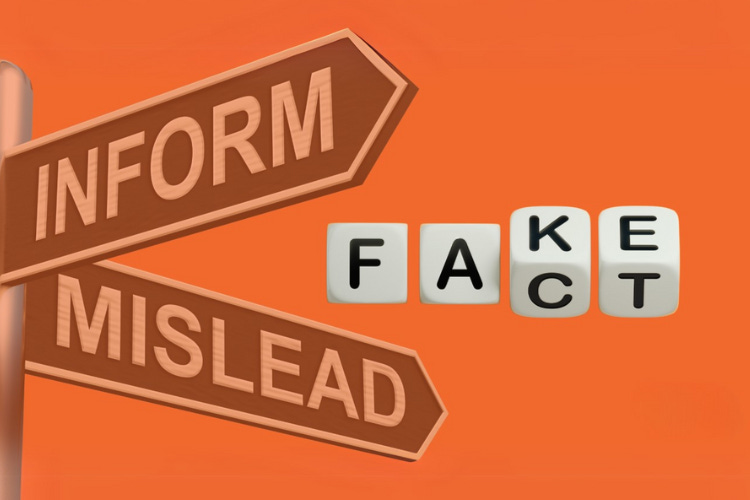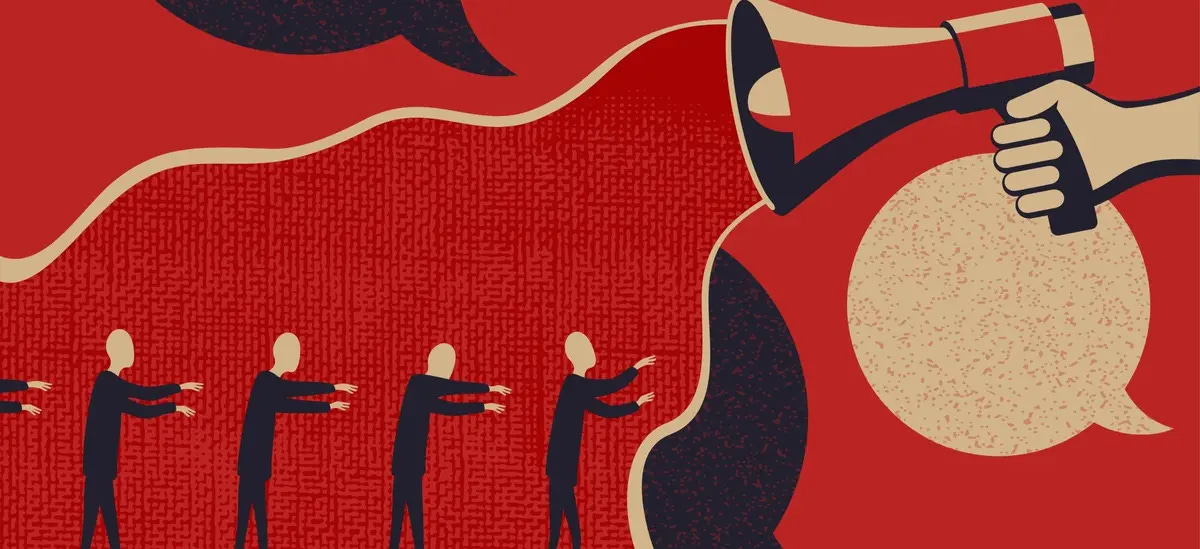What Really Counts as Propaganda?
Your guide to understanding and challenging lies inside.
Thank you for subscribing to my Substack! I use this space to provide education on social justice and social change from a sociological perspective. Thank you for reading! These articles take a lot of time to research and write, so if you’d like to support my work, please consider upgrading to a paid subscription. In any case please be sure to like, comment and share!
I. Introduction
Propaganda was once thought of as a tool of "other" societies—an Orwellian nightmare confined to totalitarian regimes, with loudspeakers blaring political dogma and state-run TV controlling the narrative. Yet, here we are in an ostensibly democratic society, where propaganda is not only pervasive but perhaps just as insidious. Its power lies in its subtlety: it’s harder to spot, easier to internalize, and all the more dangerous.
In this age of fractured media and ideological echo chambers, many of us are confronting a tough realization—not only have we been lied to, but those lies have deeply shaped how we understand the world. It’s a reckoning with the narratives we once believed and the institutions we once trusted.
This moment of cognitive dissonance asks us to consider what really counts as propaganda in a “free” society? How does it operate when there are no obvious censors, only algorithms and corporate interests? And why, when access to truth is more available than ever, does it feel harder to locate? Ultimately, the question comes down to whether the democratization of information empowers us or fractures our ability to discern what is real.
II. What is Propaganda?
At its essence, propaganda is the deliberate shaping of perceptions to influence behavior. It bypasses reason, striking at the heart of human emotion. It tells a story, one crafted not to inform but to persuade, to reinforce a particular worldview or serve a specific agenda. And while its methods may range from slogans and emotional appeals to the subtle reframing of facts—its power lies in its ability to make the manipulated feel as though they are discovering the truth on their own.
What sets propaganda apart from other forms of communication is its relationship to power. It’s wielded to maintain or expand control, and it thrives on the imbalance between those who create narratives and those who consume them. In democratic societies, where the press is ostensibly free, propaganda may not typically take the form of blatant lies or enforced censorship. Instead, it more commonly operates in more sophisticated ways, using framing, omission, and repetition to create a consensus that appears natural and unassailable.
This dynamic is central to the work of Noam Chomsky and Edward S. Herman, whose Manufacturing Consent exposed how media in free societies serves elite interests. They argued that rather than telling people what to think, propaganda in democracies works by defining what topics are worth thinking about and how those topics should be framed. During the lead-up to the Iraq War, for instance, the U.S. media widely disseminated the government’s claim that Iraq possessed weapons of mass destruction. Alternative perspectives were sidelined, leaving little room for public debate. Only later, after the war was well underway, were the lies exposed and the consensus unraveled.
But propaganda doesn’t work through information alone. Its true strength lies in its emotional pull, a point explored by theorists like Jacques Ellul. Propaganda, Ellul argued, isn’t effective because it convinces people logically but rather because it resonates with their fears, hopes, and desires. It exploits the shortcuts our minds take when faced with complexity, appealing to our instincts rather than our intellect. In other words it turns affects into beliefs. A powerful example can be found in the “war on terror,” a phrase that conjures images of an existential threat and moral urgency. It frames a complex geopolitical struggle as a battle between good and evil, silencing nuance and dissent in the process.
But this kind of emotional resonance is not always rooted in fear. Propaganda can also inspire, offering visions of unity, progress, or justice. Movements for social change often rely on similar tools, crafting narratives that galvanize collective action. The difference often lies in intent. Whereas propaganda manipulates to serve narrow interests, movements for justice aim to expose hidden truths, building solidarity rather than silencing opposition.
If we look deeper, we see that propaganda also thrives on invisibility. The Italian Marxist Antonio Gramsci understood this well, describing how power is maintained not just through force but through cultural norms and beliefs. He called this “cultural hegemony,” a process by which dominant ideologies become so ingrained in society that they feel natural, even inevitable. In the United States, for example, the idea of the “American Dream” suggests that hard work and individual effort are the keys to success. But this narrative typically obscures systemic barriers like racial inequality, economic exploitation, and the role of inherited wealth. It is a story that upholds power by shifting focus away from the structures that sustain it.
But not all persuasive communication is propaganda. For example, campaigns promoting literacy or seatbelt use may employ emotional appeals or repetition, but they are generally rooted in transparency and evidence. What distinguishes propaganda is its intent to obscure or distort the truth, often serving the interests of a few at the expense of the many.
Understanding propaganda requires recognizing its tactics and also questioning the systems that sustain it. In a world of too much information, the challenge isn’t a lack of access but an overwhelming abundance of competing narratives. Propaganda exploits this noise, slipping through the cracks of our attention, and embedding itself in our worldview. If we are to resist its pull, we must develop the tools to see it clearly—not just as a feature of authoritarian regimes but as a force that shapes our daily lives, often without our knowing.
III. The Crisis of Trust and Rise of Polarization
The Decline of Trust in Media
For much of the 20th century, trust in the American media was remarkably high. In the 1970s, close to 70% of Americans believed that the press reliably informed the public. This confidence, however, has crumbled over recent years. By 2024, fewer than one-third of Americans expressed trust in the media—a collapse that reflects both the media’s shifting role in society and a broader crisis of institutional trust.
The reasons for this decline are multifold. Perceived bias has long been a point of contention, as partisan divides have deepened and media outlets have increasingly catered to ideological audiences. Economic pressures on journalism have also played a role. The transition from print to digital media disrupted traditional revenue streams. In response news organizations prioritized sensationalism and clickbait in order to survive in an increasingly competitive landscape.
The decline in trust came alongside the cognitive dissonance we faced by having to reckon with media failures. High-profile events like the Iraq War revealed how often mainstream outlets failed to challenge powerful institutions. The media’s complicity in amplifying government claims about weapons of mass destruction was a turning point that left many of us questioning whether the press serves the public interest or the interests of the powerful. Similarly, the rise of gig economy platforms like Uber and DoorDash was often framed as a story of innovation and empowerment, with almost no attention given to the precarious working conditions and lack of labor protections faced by their workers.
It’s not like these failures have gone unnoticed. The growing awareness of how narratives are shaped, filtered, and manipulated has fueled widespread skepticism. People feel misled, and are struggling to figure out what information they can trust.
The Fragmentation of Information Sources
As trust in traditional media has eroded, the landscape of information has become fragmented. Social media and digital platforms have become dominant sources of news, particularly for younger Americans, fundamentally reshaping how information is shared and understood.
For adults under 30, platforms like Instagram, Twitter, and TikTok are nearly as trusted as national news outlets. These platforms promise immediacy and democratization, but they also introduce new problems. Algorithms prioritize engagement. This means that they favor sensational, emotionally charged content over nuanced reporting. The result is a news ecosystem where speed trumps accuracy, and the loudest voices drown out the most informed ones.
This shift has also revealed generational and racial divides in how Americans consume news. Older adults, particularly those over 50, continue to rely on traditional outlets like television and print media, while younger adults gravitate toward podcasts, YouTube, and social media. Black Americans are more likely to turn to television for news than their white or Latinx counterparts, reflecting both cultural preferences and systemic barriers to digital access. Meanwhile, younger Latinx adults are among the least engaged with news, often citing disillusionment or a lack of representation as reasons for their detachment.
This fragmentation of news consumption creates a double-edged sword. On one hand, digital platforms offer unprecedented access to diverse perspectives and grassroots reporting. But on the other hand, they exacerbate the challenge of distinguishing credible content from inaccurate information or propaganda. This leaves users to navigate a chaotic and polarized information media landscape - and honestly, who has time for that?
Polarization, Echo Chambers, and Social Divide
The consequences of this fractured media environment are serious. As audiences retreat into ideologically aligned corners, media polarization has become a key driver of societal division. Selective exposure ensures that individuals encounter only the narratives that confirm their beliefs, creating echo chambers that deepen mistrust and intensify animosity toward opposing views.
Social media amplifies polarization in profound ways. Algorithms designed to maximize engagement often elevate the most emotionally charged and divisive content, rewarding outrage and controversy with visibility. This dynamic creates a distorted picture of public discourse, where extreme opinions appear more common and reasonable ones are drowned out. In this fragmented media environment, misinformation spreads unchecked, reinforcing existing biases and deepening divisions.
Propaganda plays a crucial role in this process, embedding incorrect facts into polarized narratives that leave little room for dissent or dialogue. During the COVID-19 pandemic, for instance, narratives about vaccine safety and the origins of the virus became flashpoints for political and social conflict. Propaganda framed vaccines as universally necessary, without sufficient acknowledgment of individual risks or emerging concerns, while simultaneously labeling dissenters as morally irresponsible. This binary framing not only stoked fear and resentment but also led to personal and societal fractures, with families and communities ostracizing members who diverged from the dominant narrative.
The current political climate further illustrates how propaganda-driven polarization leads to entrenched divides. Consider how some voters have responded to the Harris loss, convinced that their moral stance justifies cutting off those who disagree. This moral absolutism is amplified by selective narratives in the media, reflecting the broader impact of propaganda in creating echo chambers where opposing views are not only dismissed but vilified.
Rather than fostering meaningful debate or collective problem-solving, this environment entrenches division, leaving society less equipped to address the challenges we face. The issue is not simply one of differing opinions but of a fractured sense of shared reality—a gap that propaganda exploits to its fullest.
The connection between polarization and instability is clear. As trust erodes and divisions deepen, democratic systems are left vulnerable to manipulation, coercion, and collapse. To understand this trajectory is to recognize the urgency of addressing how media operates, as a force that actively shapes divides.
IV: How Propaganda Works
Propaganda is a deliberate act of shaping perception and behavior. Its success depends on the structures of power and the emotional vulnerabilities it exploits. In the modern age, propaganda infiltrates every corner of our lives—it’s embedded in algorithms, cloaked in entertainment, and disguised as news.
Propaganda operates on two levels: the visible and the invisible. The visible mechanisms—the slogans, posters, and hashtags—are easy to recognize. But beneath them lies a more insidious layer, where narratives are framed, facts are omitted, and dissent is subtly delegitimized. Propaganda thrives on repetition and simplicity, reducing complex issues into digestible messages that appeal to emotion rather than reason. It is, above all, an exercise in power: who controls the narrative, and for what purpose?
The Mechanics of Persuasion
One of propaganda’s most powerful tools is emotional resonance. Human decision-making is rarely purely governed by logic; we are driven by fear, hope, anger, and pride. Propaganda taps into these emotions, bypassing critical thought and embedding itself in our subconscious. For example, during economic downturns, propaganda often frames systemic challenges as the fault of scapegoats—immigrants, foreign nations, or marginalized groups—stoking fear and resentment. The structural causes of inequality or a bad economy fade into the background, overshadowed by the emotional pull of blame and the promise of a quick solution.
Emotional appeal works best when paired with simplicity. Complex realities are boiled down to binaries: good versus evil, us versus them, progress versus regression. In these frames, there is no room for nuance or dissent. This simplicity is not a failure of thought but a deliberate strategy, designed to create a narrative that is easy to internalize and difficult to question.
Repetition reinforces these narratives. When a message is repeated across multiple platforms—television, social media, political speeches—it begins to feel like common sense, even when it lacks evidence. This repetition creates what cognitive scientists call the “illusion of truth,” where familiarity breeds acceptance.
Framing and Agenda-Setting
While propaganda often involves outright lies (i.e. beheaded babies), its most effective forms are more subtle. Framing—the way information is presented—shapes how we interpret the world. Consider the difference between calling a policy “tax relief” versus “tax cuts.” The former suggests liberation from a burden, while the latter implies favoritism or harm. Both phrases may describe the same policy, but their framing leads to entirely different interpretations.
Agenda-setting, meanwhile, determines what we talk about and what we ignore. Media outlets play a significant role in this process. By choosing which stories to amplify and which to sideline, they define the boundaries of public discourse. During the COVID-19 pandemic, for instance, coverage often focused on individual responsibility—mask-wearing, social distancing—while systemic failures in public health were covered up.
These tactics highlight one of propaganda’s greatest strengths: its ability to control not just what people think, but what they think about.
The Role of Algorithms
In the digital age, propaganda has found a new ally in algorithms. Social media platforms, driven by engagement metrics, amplify content that provokes strong emotional reactions. Outrage, fear, and excitement generate clicks and shares, rewarding content that polarizes and sensationalizes. This creates a feedback loop: divisive messages are promoted, reaching larger audiences, while measured or nuanced perspectives are drowned out.
Algorithms also create personalized echo chambers. By analyzing user behavior, platforms curate feeds that reinforce existing beliefs, insulating users from conflicting viewpoints. This fragmentation of information contributes to the rise of parallel realities, where two individuals can experience entirely different versions of the same event.
But algorithms do more than amplify division; they obscure accountability. Unlike traditional media, where biases can be debated and editors held accountable, algorithms operate as black boxes. Users rarely understand why certain content appears in their feeds, making it harder to challenge or resist its influence.
Information Laundering and Astroturfing
Modern propaganda often hides its origins, appearing to come from independent or grassroots sources. This tactic, known as information laundering, lends credibility to biased narratives by masking their true authors. A think tank funded by an oil company might publish a report downplaying climate change, which is then cited by media outlets as an independent study. The result is a message that appears objective but is, in fact, deeply influenced by vested interests.
Astroturfing takes this deception a step further. By creating fake grassroots movements, propagandists simulate public support for a cause. Online, this might involve bots or paid commenters flooding social media with hashtags and posts. Offline, it could mean orchestrating protests that appear spontaneous but are backed by powerful entities. These tactics distort public perception, making a minority viewpoint seem like a majority consensus—or vice versa.
The Erosion of Truth
The ultimate goal of propaganda is not just to persuade but to destabilize our relationship with truth itself. In a world where misinformation abounds and narratives compete for dominance, the line between fact and fiction becomes increasingly blurred. This erosion of truth creates fertile ground for propaganda to flourish.
Once trust in institutions and expertise is broken, individuals are left to navigate the information landscape alone. This often leads to what scholars call “truth fatigue,” where people disengage altogether, no longer sure who or what to believe. For propagandists, this is a victory: in the absence of trust, their narratives face less scrutiny and encounter less resistance.
V: A Brief Guide to Spotting and Challenging Propaganda
Recognizing and resisting propaganda requires a sharp eye and an active mind. In a world where narratives compete for our attention, it is easy to become overwhelmed or misled. But by developing critical thinking skills and cultivating media literacy, we can better navigate the information landscape. Here is a practical guide to spotting and challenging propaganda in our daily lives.
Recognizing Propaganda
Question Emotional Appeals:
» Ask yourself: How does this message make me feel? Propaganda often aims to provoke strong emotions—fear, anger, pride, or hope—to bypass critical thinking. If a message feels designed to manipulate your feelings, take a step back and evaluate it objectively.
Identify Simplification and Binary Thinking:
» Look out for messages that reduce complex issues to oversimplified choices or "us vs. them" narratives. These are hallmarks of propaganda that obscure nuance and discourage debate.
Analyze Framing:
» Pay attention to the language and context of the message. Is it framed in a way that subtly pushes you toward a specific conclusion? Consider how alternative phrasing might change the meaning or impact.
Check for Repetition:
» Notice if the same message or phrase is repeated across multiple platforms or contexts. Repetition is a key tactic for normalizing propaganda and creating the illusion of truth.
Evaluate Sources and Missing Context:
» Investigate the source of the information. Is it credible and transparent about its intentions? Be mindful of what is not being said—omissions can be just as telling as what is included.
Strategies for Resistance
Develop Media Literacy:
» Get comfortable with fact-checking tools and techniques, such as cross-referencing claims. Do your own research and search for differing opinions actively.
» Stay skeptical of sensational headlines and viral posts, which often prioritize engagement over accuracy.
Seek Diverse Perspectives:
» Actively expose yourself to a range of viewpoints, especially those you may disagree with. This can help you avoid echo chambers and gain a more balanced understanding of complex issues.
Ask Critical Questions:
» Who benefits from this message?
» What evidence supports this claim?
» Is the information presented as part of a larger pattern or selectively chosen to fit a narrative?
Practice Patience and Reflection:
» Resist the urge to form an opinion immediately or to react emotionally charged content. Take time to investigate, reflect, and verify before forming a conclusion or sharing the message with others.
How to Challenge Friends and Family Who Have Been Influenced by Propaganda
Challenging someone’s belief system, especially when it has been shaped by propaganda, is a delicate and often frustrating process. People rarely change their minds when confronted directly with facts, particularly if their beliefs are tied to identity, fear, or group loyalty. Effective strategies require empathy, patience, and an understanding of how propaganda manipulates emotions and perceptions.
1. Understand the Emotional Roots of Belief
Propaganda is often powerful because it speaks to emotions like fear, pride, or belonging. Someone who believes a false narrative might not be persuaded by facts alone because their belief satisfies an emotional need or reinforces their identity.
Approach:
Begin by understanding what emotional or psychological need the belief fulfills. Are they feeling fear for their safety, loyalty to a political group, or distrust of authority?
Acknowledge their feelings without validating the misinformation. For example: “I can see why that story would be so upsetting.”
2. Ask Questions
Instead of confronting someone with counterarguments, guide them to question the belief themselves. This technique encourages reflection without triggering defensiveness.
Example:
For someone who believes the “beheaded babies” story:
“That’s a horrifying claim. Where did you first hear it?”
“Do you think it’s possible for leaders to repeat something before verifying it?”
“What would it mean if the story turned out to be false?”
This method shifts the conversation from argument to inquiry, reducing defensiveness and opening space for reconsideration.
3. Share Information Strategically
Bombarding someone with evidence rarely works, especially if they feel attacked. Instead, share carefully selected information from sources they trust or respect.
Tactics:
Avoid overwhelming them with data. Focus on one key piece of evidence or a single contradiction in the narrative.
Frame it as a joint exploration:
“I came across something interesting and wanted to get your thoughts on it.”
“This article raised some questions for me. Does it make sense to you?”
4. Highlight the Broader Pattern of Propaganda
Sometimes, it’s helpful to step back from the specific belief and address how propaganda operates. Drawing attention to patterns can encourage skepticism toward all narratives, not just the one in question.
Example:
“Isn’t it interesting how often stories turn out to be exaggerated or even false when emotions are running high? I think it’s important to take a step back and see who benefits from those stories being believed.”
This reframes the issue as part of a systemic problem rather than a personal one, reducing the likelihood of conflict.
5. Know When to Step Back
Not every conversation will lead to immediate change, and pushing too hard can backfire. If someone becomes defensive or entrenched, it’s often better to step back and leave the door open for future dialogue.
What to Say:
“I get that this is something you feel strongly about. I appreciate you talking with me, and I’d love to keep the conversation going when you’re ready.”
This signals respect for their autonomy while subtly encouraging further reflection.
6. Encourage Critical Thinking Over Time
Challenging propaganda is rarely a one-time conversation. Encourage ongoing habits of skepticism and inquiry by:
Sharing tools for evaluating sources, like fact-checking sites or guides to spotting bias.
Encouraging them to explore a variety of perspectives on issues they care about.
Modeling curiosity and openness yourself.
For example:
“I used to believe {X} until I looked into it more deeply. It’s so interesting how our views can change when we see the bigger picture.”
7. Recognize Propaganda’s Social Dimension
Many beliefs are reinforced by social networks, whether online or offline. Addressing misinformation often requires addressing the community or echo chamber that sustains it.
Action Steps:
Ask: “Have you noticed if most of the people around you feel the same way about this? Why do you think that is?”
Suggest expanding their network to include diverse perspectives: “I’ve found it helpful to follow people with very different views—it keeps me on my toes.”
8. Stay Compassionate
Finally, remember that none of us is immune to propaganda, and being misled does not make someone irredeemable. Your goal isn’t to “win” the argument but to plant seeds of doubt and curiosity that may grow over time.
By approaching these conversations with empathy, patience, and strategic thinking, you can help counter the effects of propaganda without alienating the people you care about.
VI. Conclusion: Building a World Beyond Propaganda
If there is one lesson to take away from this exploration, it is that the antidote to propaganda is not cynicism but curiosity. The proliferation of information feels overwhelming, but it also represents an opportunity: to seek out new perspectives, to ask better questions, and to challenge the narratives that limit us. Every time we step outside of an echo chamber, engage in thoughtful dialogue, or demand accountability from those in power, we weaken propaganda’s hold.
Resisting propaganda requires both individual effort and collective action. Open dialogue is a powerful tool—engaging with those who hold different opinions can dismantle stereotypes and foster understanding in a polarized world. No, it’s not an easy task. It requires patience and persistence, and it demands that we confront uncomfortable truths about our own biases and blind spots. Propaganda thrives on isolation and division, but the human capacity for connection and understanding is far greater.
We are living through a moment of profound change, where old ideals are crumbling, and new possibilities are emerging. If we can see through the fog of propaganda and rediscover our shared humanity, there’s nothing we can’t build.
Thank you for subscribing to my Substack! I use this space to provide education on social justice and social change from a sociological perspective. Thank you for reading! These articles take a lot of time to research and write, so if you’d like to support my work, please consider upgrading to a paid subscription. In any case please be sure to like, comment and share!








Tremendously insightful and helpful, Pamela. Well-written and on-point. Truthful. Thanks for this great contribution!
Everything coming from the mouths of western government officials, newspapers, media